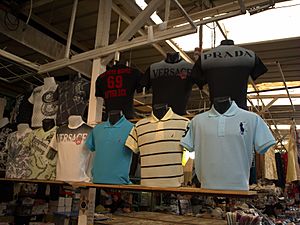Counterfeit facts for kids
To counterfeit something means to make a fake copy of it. Counterfeit products are items that look like the real thing but are not made by the original company. People make these fake items to trick others into thinking they are valuable, genuine products.
You can find counterfeit versions of many things. This includes fake currency (money) and documents. It also applies to items like clothing, handbags, shoes, medicines, car parts, watches, electronics, software, art, toys, and movies.
Counterfeit products often have fake company logos and brands. This means they copy the original company's design without permission. These fake items are usually much lower quality. Sometimes they don't work at all. They can even contain harmful things, like lead. This can be very dangerous. For example, fake car parts or medicines can cause serious accidents or health problems.
Governments around the world work hard to stop the making of fake money. Paper money is one of the most common things to be counterfeited.
Contents
What is Counterfeiting?
Counterfeiting is when someone makes a copy of something without permission. They do this to make money by tricking people. These fake items are often called "knock-offs" or "rip-offs."
Fake Money and Bonds
Counterfeit money is cash made without the government's approval. It is illegal to produce or use fake money. Governments take this crime very seriously.
Fake Documents
Forgery is the act of making or changing documents to trick people. This is a type of fraud. It is often used in identity theft, where someone pretends to be another person.
Fake Everyday Items
Fake consumer goods are now found all over the world. The types of items being copied have grown a lot. Clothes and accessories are often copied. Over half of the fake goods found by U.S. Customs and Border Control were clothing and accessories.
Images for kids
-
A U.S. CBP agent checking a travel document at an international airport
-
Fake LG brand products, like TVs and air conditioners
-
A real Intel flash memory chip (right) and a fake one (left). X-rays show the fake one is different inside.
See also
 In Spanish: Falsificación para niños
In Spanish: Falsificación para niños







